‘Built on the orders of the sun king, Louis XIV, the Canal du Midi is listed by the UN as one of the “most remarkable feats of civil engineering” but also a natural work of art.’ Wikipedia
The rest of the comments in italics are those of Captain Stu

We had crossed the Étang de Thau on a clear blue breezy day, heading for the entrance to the Canal du Midi marked by a conical lighthouse. Hooray – we had reached our waterway destination, 5 months and two days after leaving Eastbourne to cross the channel. We could now relax, enjoy the Mediterranean sea and sunshine, and dawdle our way to our winter mooring site at Castelnaudary.
The first stretch seemed so narrow after the Étang, lined by boats on both sides, and warm worn old buildings on one bank.

Every canal has its own set of scenery, or indeed several sets of scenery. The Canal du Midi began fairly Camargue like – flat with étangs to one side or another, with reeds and grasses moving in the gentle winds.
 We made our way along to the first of the distinctive Midi oval locks (also known as blooming bonkers – we grate up and down either end and miss in the middle by two foot). A rather grumpy éclusier refused to respond to my cheerful chatter (who could blame her in that heat?) but she did get to work and lock us and another boat up 1.5m to the next level.
We made our way along to the first of the distinctive Midi oval locks (also known as blooming bonkers – we grate up and down either end and miss in the middle by two foot). A rather grumpy éclusier refused to respond to my cheerful chatter (who could blame her in that heat?) but she did get to work and lock us and another boat up 1.5m to the next level.
Stu’s next obstacle was persuading Calliope through the first tight fitting bridge, Pont de Trois Yeux. She behaved perfectly and we glided through the central arch, and out the other side with no mishap. (Breathe in, close your eyes . . . .)
 Calliope continued along the canal towards one of the most interesting locks in France – the round lock at Adge, a three way connection between the canal and the south bound arm of the river Herault. We arrived at lock keepers lunch time, ready to moor up on the waiting pontoon and eat our own while we waited.
Calliope continued along the canal towards one of the most interesting locks in France – the round lock at Adge, a three way connection between the canal and the south bound arm of the river Herault. We arrived at lock keepers lunch time, ready to moor up on the waiting pontoon and eat our own while we waited.
Hurumph! The pontoon was full of boats that should not be there. One was a boat that had come through the lock and was heading towards the Étang; the other two had simply moored up, maybe for ever! There was no sign of any help or apology from any of them, and one was British. I have to say I was somewhat disgruntled.
Meantime we, and the other upstream boat, had to somehow get close enough to a steep bank for me to jump ashore with rope, whilst not running aground in the shallows. It was not easy, but we made it, and were able to sit back and enjoy lunch in the shade.
At 13.30 a smiling lock keeper helped and advised us into the lock-circle and through the 60cm rise. On we went, past another lovely old canalised building.
We aimed to spend the night at Vias, where we were picking up a replacement PV panel. Our initial thoughts on arrival were that there was nowhere for us to moor, so hot, tired, and therefore a bit fractious, I phoned the guy with the panel.

Life changed at that point! Mick (aka The Pirate) told us that a narrow boat opposite him was just leaving and we took her place near the old bridge – there we are on the left, second boat along.. The people and place were so pleasant that instead of the planned two night we doubled it up to four.
The mooring is on a busy section of canal with holiday boats passing quite frequently, but pleasantly. The light along the canal in the mornings just catches the bridge and warms it up to honey tones.
The small town of Vias, about 1.5KM away, has a genuine old centre with good shops for food and wine selling on an industrial scale! Take in an empty 1 litre plastic bottle and they will fill it for €1.10. Take in something larger to be filled, out comes the hose, and your container will be full of wine in no time.

Vias Plage is a popular Med-side holiday destination, so no surprise to see all kinds of vacation entertainment, including a neon lit fair that, although quite close, was not too noisy and only open at the weekend.
We walked down to ‘la Plage’ one day for a dip in the sea – the weather was in the thirties every day, even in September; glorious. The beach was so hot that Stu went to buy a cheapo end-of-season parasol; its shade made all the difference to our picnic. Beach, grumpy, moi?
Stu paddled, I swam and lolled about in the water a bit, like a basking seal but not as elegant!
Far more elegant, in an arty kind of a way, was the almost silhouette of a young girl on the rocks with her bucket and spade. Had to include these photos.
We made several friends whilst moored up at Vias, not least amongst them a four legged friend. This young female feral cat took a fancy to us and the boat next door. She took to guarding us all, seeing off dogs much larger than herself with no fear. Martin and Carol think they will adopt her, seducing her with tinned salmon! She has been named Viz, sort of after Vias. Great to meet up with Martin and Carol for the fourth time: (i) Limehouse (ii) Bisham Abbey (iii) North Foreland 2 miles off (iv) the Midi – and big thanks for the electro-help Martin.

As the season is ending, so are my flowers. The sunflowers that have been our figurehead down through the canal and river system are now giving up their seeds; I will keep some to plant next year for the 2017 voyage.

So goodbye Vias, goodbye little cat and the human friends we have made over the past few days. With bread, ham, paté and tomatoes on board we are ready to head off. Not long after passing under the bridges at Vias we came to quite a structural masterpiece, Passages du Libron.
The current structure, built in 1857, replaces a more modest attempt to keep the floodwaters of le Libron river from destroying the canal. The river is divided into two branches each side of the canal and in the event of a flood big gates at each end are closed, cutting off the two river branches form the canal. It would be interesting to see it in practise!

We continued on through low lying almost brackish countryside to the lock at Portiragnes and its pretty bridge.

Safe through the lock we started to see the kind of scenery that we had remembered from a previous trip along the Canal du Midi – a mainly straight calm waterway, shaded by the celebrated plane trees, now over 180 years old.
 Many of these beautiful trees are now sick, or have died, due to the fungus Ceratocystis platani, which is believed to have been brought to France in contaminated ammunition boxes used by US troops during the second world war. We passed yet another sad section necessarily being cut down. But new trees, mainly poplar, oak and pine, all resistant to the fungus, are being planted for future boating generations to enjoy.
Many of these beautiful trees are now sick, or have died, due to the fungus Ceratocystis platani, which is believed to have been brought to France in contaminated ammunition boxes used by US troops during the second world war. We passed yet another sad section necessarily being cut down. But new trees, mainly poplar, oak and pine, all resistant to the fungus, are being planted for future boating generations to enjoy.

We came on through Pont de Caylus, up the canal and to Villeneuve-lès-Béziers to look for a mooring – not an easy task! Eventually we found a spot with dodgy mooring poles, and with a strong breeze blowing us off the bank we had an interesting struggle to get ropes ashore and secure. Luckily another kind boater helped us.
If you are ever coming here aim to moor on the stone quay just below the lock where there are bollards and water!
A stroll round the small town uncovered a much older and more interesting place than we had imagined from the name Villeneuve (new town). The troupe d’ceil is superb – painted on a completely flat front, but seemingly a grand house with sweeping steps and balcony.

Next morning it was our turn through the lock – actually second in turn as the éclusier didn’t see us pull out from our mooring to join another boat going into the lock.
(This photo is my camera’s attempt at being arty I think!)
While we were in the lock Stewart noticed that we had a little green stowaway on board – a small frog, able to walk down vertical surfaces with sticky feet! He hid in a dimple at the top of a fender.
So on up the canal we went, passing an unexpected lift bridge with a little operators cabin in the centre. The bridge remains up for canal traffic, but can be lowered a few feet when road access is needed; fascinating mechanisms again.
Here’s the next bit of excitement – heading for what we knew was a narrow bridge on a bend, we were suddenly confronted by an even bigger barge than us coming the other way!

Pleased to say that the Captain approaches these blind corners with caution, and it was a comfortable manoeuvre to stop, reverse and negotiate the passage port to port as prescribed.
Not long after we came into Bezier basin through the lower lock, and were met by a smiling Capaitine of the port who guided us to our mooring – straight opposite this beautiful Art Nouveau villa.
It has so many nice features, the roof, the gable end tiles, the wrought iron, the stone carvings, etc, that I had to do show several photos to do it justice.
We did not take the trip up into old Beziers, at the top of the hill, as we only had one night in port. I managed a skyline photo as we left the next morning, and one across several of the bridges over l’Orb river towards the Pyrenees.
Our Friday voyage began through the tall, but very gentle, Orb écluse. Around the bend following the lock we went over the viaduct called ‘Pont-canal de Béziers’. This straddles the l’Orb as it makes its peaceful way down to the sea.
All of this, plus a quiet kilometre’s cruising and half hours ‘waiting’ mooring lulled us into a false sense of relaxed anticipation for the maelstrom ahead – the Fonserannes Staircase of seven locks taking us up 22m.
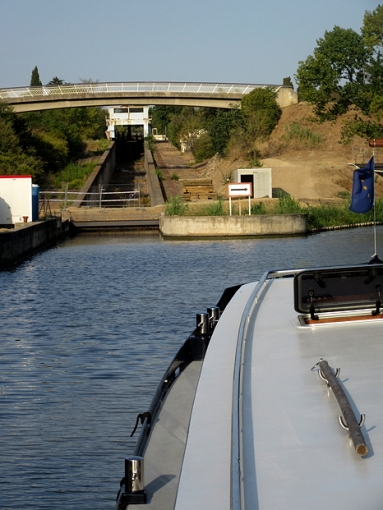
We waited across the channel from the ill fated ‘incline’, designed and built in the sixties to raise and lower boats using hydraulics, instead of the staircase of locks. It only operated two or three times before the brakes failed …….
It is a different process to our previous mega-lock experiences. Each lock is a slight oval, with mooring bollards that are not always easy to reach, this making the securing of a 20m barge a small challenge.

To accomplish the mooring I walked up the steps between locks, leading Calliope like a young horse, and tied the front rope. I could then go back and catch (eventually) the stern rope thrown up 3/4m by Stu and pop it round a bollard for him.
 As you go into one lock the doors to the one above are also open, a massive cill, or shelf, above the waterline, and water already pouring in. Almost before you can tie up the gates behind close and the water starts to thunder in from the lock above, threatening to move 38 tons of steel around in the chamber if you don’t hang on tight!
As you go into one lock the doors to the one above are also open, a massive cill, or shelf, above the waterline, and water already pouring in. Almost before you can tie up the gates behind close and the water starts to thunder in from the lock above, threatening to move 38 tons of steel around in the chamber if you don’t hang on tight!
Actually I make it sound more difficult than it is, so if you’re contemplating them please don’t be put off – just be prepared. We got to the top quite quickly and were able to look back down the incline we had just climbed. (Double bonkers!)

The rest of the mornings journey was as peaceful as the beginning, through the countryside along a narrow winding canal.

We reached Colombiers in plenty of time to moor up next to a willow tree and the bridge, and enjoy lunch in the sunshine……..
.

…. although we had to deploy a somewhat Heath Robinson arrangement of ropes and stakes to be secure as other boats washed past!
Colombiers has a chateau, a low narrow bridge, and, hooray, a lavoir! (If this is the first of these blogs you have read you will not be aware of my passionate interest in lavoirs, or old waterside places for villagers to wash their clothes.)

We were impressed by the passenger barge squeezing back and forth through the bridge, each time looking to me as if it could not possibly fit.(Slow, effortless and seriously cool.)
I rather liked Colombiere’s Grand Rue. Oh for the days when a narrow pretty street could be the grand rue of a village! The local method of edging a roof is somewhat different too – curved terracotta tiles in two rows creating a small overhang.
An unexpected thunderstorm in the early hours of the next day cooled the air and washed the boat before we left Colombiere for Capastang, 11 kms away.

By the time we left the skies were becoming blue again, although the last of the grey made a good background for the last of our tomatoes.
We went through the world’s first canal tunnel at Malpas tunnel, built in 1679-80, partly in secret after prime minister Colbert told Riquet, the canal engineer, that he was to take the canal over L’Aude river instead.(The first canal in the UK, the narrow Bridgewater was opened in 1761). The hill itself is fascinating, having the Roman road Via Domitia on top, a 19th century railway tunnel below the canal, and deep down the longest and oldest tunnel (1364m) built in 1250-70 by monks to drain the Étang de Monday.

The canal wound round the side of a hill, looking out over a huge scene below, and with many a tight narrow turn, especially as we passed through Poilhès and its bridge. Then an unexpected treat – a lavoirr on the port side just after the bridge.
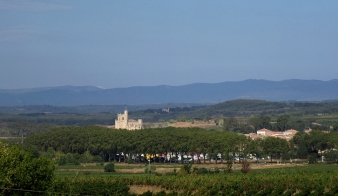
Soon after Poilhès we caught our first sight of Capestang across the plateau.
We arrived in Capastang in time for lunch and to finish preparations for our mates Dave and Colleen to stay. Once they were installed aboard we all went for a beer-in-the-square and to explore part of this historic village and its old multi-century church and then another beer-on-the-boat if I remember correctly.
Next morning we allowed time to visit the Sunday market, getting in essential supplies – wine, leeks, bread, tarte tatin, peaches and onions. With those stored aboard Calliope slipped away upstream towards the most famous bridge on the canal – due to its sloping shoulders.
Everyone is warned about Capestang bridge, and their was paint of various hues left on the masonry as proof of the potential difficulties, but Captain Stu steered us through perfectly.

We continued on along a beautiful, windy stretch of canal with big scenic views to the South – sadly created by the lack of plane trees. But we saw plenty of evidence of new trees being planted too, so in 20 years it will be back to its former shaded glory.
I was sharing photo opportunities with Dave and Colleen now – this one of Pont de Pigasse.

We came into Ventenac-en-Minervois and noticed a pleasant mooring just before the bridge.
The other side of he bridge we discovered the local wine producer. He had a superb canalised building, reminiscent of a chateau, with his cellars at the back and an old barge moored up at the front, complete with giant ancient barrels for transporting the wine in times gone by.
We had a lovely evening there, with supper on board, and watched the fading sun go down behind the bridge as we sampled some of the local wine.
We were on a mission to get Dave and Colleen to Carcassonne before they had to go home so next morning we were up and away at a reasonable time, tootling on ever Westward.
We passed over several aqueducts over a series of rivers, the second being over la Repudre, on an almost hairpin bend of the canal. It has to be said that the stonework was more magnificent than the river below.
This bridge, built in 1676, is the first canal bridge ever build in France, and reputedly the second oldest in the world!
Paraza came into view at this point, shortly followed by Roubia and then Argens-Minervois where we stopped to buy bread and have lunch. D and C went in search of a boulangeries and returned with quiches too!

We had a double lock at Pechlaurier to navigate after lunch, and wished we had cut short our break to set forth earlier. This was the first time we really had to queue for a lock!
At least we could all enjoy the sun and scenery as we waited for boats to go up, boats to come down, and then our turn.
It was a day of double locks, the next pair being at Ognon.
Again we had to wait, this time watching a big hotel boat descend in stately fashion from top to bottom.
One of the bigger elevations here, for the Canal du Midi, being 5.81m over the two chambers.
We found that we had not progressed as quickly as hoped towards our planned ‘harbour’ at Homps – where we wanted to go out for dinner and celebrate Dave’s birthday.
But we did make it, and cheekily went into a mooring that was primarily for passenger boats. None turned up. We were tucked in by a bridge, under a big hill, and next to the so called best restaurant in town – which was closed!

D and C found an alternative restaurant, and after a beer at a bar on the wharf we went for an excellent meal in typically French surroundings at Le Foudre; highly recommended!
Happy Birthday Dave!
We pushed on almost 20 kilometres next day to Marseillette. We knew the weather was turing somewhat grey and wet the following day so deiced to get some locks under our belt in the dry – 2 single, 3 double, and a treble.

The first interesting canal structures of the day were the aqueduct and Épanchoir, or spillway, above the river Argentdouble.
The spillway has been there over 300 years, taking excess water from the canal to the river below, to avoid flooding. A sluice is still there in silent tribute. The towpath rises above the spillway over the arches – now used by cyclists more than horses!

Just beyond le Argentdouble is the village of La Redourt where the VNF have offices in the old ‘Lodgement du Gare de Canal’ building – where some of the supervisors of the canal, for water management and maintenance were based.
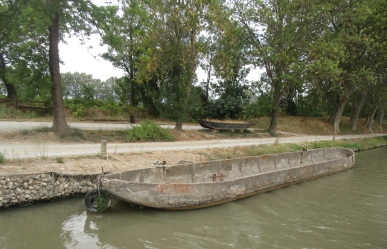
Not far away I spotted a concrete barge – something seemingly so ludicrous that I took a photo. One day someone will explain how concrete can float in a way I understand!
The second of our double locks for the day was Aiguille where the lock-keeper is also an artist, making quirky cultures out of scrap metal etc. Some of them are connected yup to the water flow and move as the lock is in operation. Fantastic.
It certainly gave us something different to look at as we came up through the two lock chambers.
After a further 3 kilometres we arrived at the triple lock (sounds like a government promise!) at Fonfile. And here we had another waiting game to play! We were fourth in line when we arrived, meaning that we would probably be in the second set to be locked up – only an hour to wait, but the clock was ticking on into the late afternoon.
As we waited a long queue formed behind us. We did manage to go up with what was the last group of the day; the rest of the boats had to moor up for the night and wait until morning. Ah well, there are worse places to spend the night.
Once up through Fonfile we had just one single lock at Marseillette between us and where we hoped to stop for the night …. the lock keeper was there, up we went, and a few minutes later we were tying up to a nice wooden jetty.
We were expecting a change in the weather, and it arrived. Through the night and on into the morning heavy rain fell, but we were optimistic that it would clear so we cast off and headed for Trèbes – not too far away.

We made it in a few hours, including the triple lock just before Trèbes town, and easily found some posts to wind our ropes around. The sun came out and we could see a pizzeria winking at us just a couple of hundred yards away.

We were set up for, and enjoyed, a very pleasant evening, with Stu having his first taste of frogs legs.
Other more sensible people had lovely filo encrusted goats cheese salad and cassoulet!
Colleen and David left us next morning, to go to Carcassonne by bus, then on to Avignon by train as stage one of theft homeward journey. We walked up to wave them good bye, and Colleen caught Stu, Dave and I loafing on the bridge. Once in a band, always in a band . . . . Cheers Matelots.
 Stu and I were ready for a rest after several days steaming along, with the added general anxiety of relatively difficult double and treble oval locks (in our size barge) so we stayed an extra day and night at Trèbes.
Stu and I were ready for a rest after several days steaming along, with the added general anxiety of relatively difficult double and treble oval locks (in our size barge) so we stayed an extra day and night at Trèbes.
I kept hearing the braying of donkeys, and with these being a favourite animal of mine I went to find them. I could not get very close, but located three pretty donkeys, sharing space with a characterful pig that gambolled around the enclosure.


The sunshine of the morning was not to last through to the night, though this did give rise to splendid, threatening, skies.
But the night remained dry; dawn was cloudy, with no hint of rain, so by 8.30 we had bought fresh baguette and were off.
The bridge out of Trèbes, on quite a bend, had looked as if it might be a bit tight, but in fact Calliope took her course through with ease and we headed into the countryside.
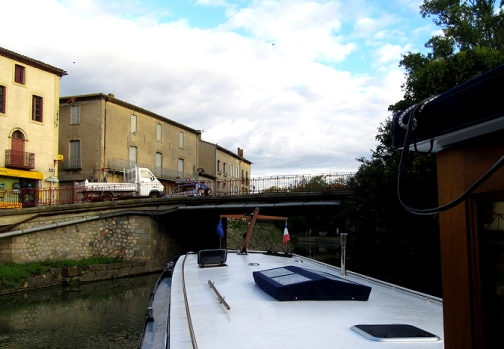
It was to be a day of bridges and locks, all the way to Carcassonne. Here’s the one that Stu, Dave and I loafed on the day before.
The locks were mainly of reasonable size and although requiring some concentration, rope throwing, ladder climbing and line hauling we got by with a bit of extra huff and puff, though did crew we had enjoyed for the last 4 days.
One double lock, Fresquel, was rather deep. When the vantelles were opened the water spurted in high, long and strong, soaking the front deck crew – much to the amusement of the dozen or so on-lookers. Luckily I love getting wet and probably laughed more than everyone else; sadly no photo to show the dripping result as the assistant photographer was busy in the wheelhouse wrestling with the elements – and keeping dry.
As for bridges, in addition to that at Trèbes, the one before the single + double locks at Fresquel was interesting and the one before St Jean lock outside Carcasonne, downright eye-catching with its stone steps and sloping sides.

We moored up to wait for Carcasonne lock in the centre of town, but out of sight of the famous old city, so no snaps of that I’m afraid. Soon after the lock we found a pleasant mooring in the cutting through the town and stopped off long enough to eat lunch.
The final stage of our day brought us to a delightful mooring by an old canal building for the spillway Épanchoir Faucault – now a Gite, but empty of guests the day we arrived. I would think that it was a wonderful Gite to rent, just outside Carcassonne, but rural, peaceful, part from the occasional train.

The spillway is bound up with the original ‘ancient’, overgrown, and mostly disappeared canal that left the Midi at this point and wound north of Carcassonne.
The structure in the photo was on the far side of the old canal and took surplus water down to a stream. The same happens now, but from the current canal.
Hope that makes sense! I have a booklet, in French, about it all if you want to see.

The owner of the gite/cafe business offered to bring us bread in the morning, so in return I said that I would take breakfast in his cafe; it was the biggest breakfast I have eaten in a while!
I ate it all!
We enjoyed the relative quiet of the mooring, and made the most of a balmy evening, well out of the wind that was blowing quite hard in the trees at the top of the cutting.
We had a ‘two by two’ plan – two nights, move on, two nights someplace else not too far away, and slowly creep up to Castelnaudary for our winter’s berth.The first stage was to be 4 kilometres and 4 locks, but the mooring on the map was a figment so we continued, and continued.
 We ended up at Villesèqueland, and both so glad that we did. Our mooring was opposite an exquisite view across the sunflower fields to the old tower in the village, with rising purple hills beyond.
We ended up at Villesèqueland, and both so glad that we did. Our mooring was opposite an exquisite view across the sunflower fields to the old tower in the village, with rising purple hills beyond.
The mooring was also opposite a 1930’s lavoir – completely different to all the previous lavoirs of the trip. This one was designed to allow local women (I assume to was mostly the women) to stand up as they washed their clothes, rather than be on their knees at water level – each in a separate ‘sink’ space, complete with a metal soap dish.
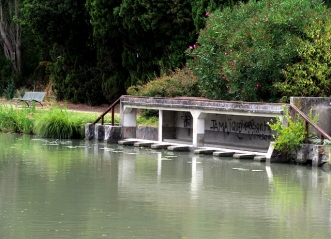
Modernity came to Villesèquelande.
Sadly the lavoir is now also complete with graffiti.

We liked the mooring and village, with its well stocked little shop, so much that we stayed a week, moored up in the countryside with the grape harvest going on around us, and in front of a very pretty little 49 footer . . . . .
Tractors and trailers regularly chugged up and over the little stone bridge between the wine cooperative buildings and the vineyards on the other side of the canal and every evening the air was thick with the fret of crushed grape and yeast.

It gave us time to get going on end-of-season maintenance. Stewart was in charge of treating small rust spots and chips in the paintwork.

I was in charge of polishing out the smaller inevitable scratches, delighting in the final reflective sheen! I also cleaned out the grey water tank, a job that I bizarrely enjoy.
I had time on my hands, and was in a static photographic position instead of constantly moving along the canal. The days were turning autumnal, giving me so may opportunity for interesting colour and light. So there were berries.
There were random flowers on various stages of their life cycle.

And sunset after beautiful sunset.
The butterflies were quietening down and the few I saw escaped my camera. But two grasshoppers, one of them a visitor on the boat, sat still long enough to be photographed.
The village of Villesèquelande has history. As far as I can make out the 12th century church and presbyterie were both originally part of a chateau, and were converted into religious use at some point in the past.
As mentioned above the view from our mooring, over the sunflower field and edge of the village, includes the tower of the church – fairly obviously built for war-like rather than religious purposes. The bell is on a nearby building.
Villesèquelande is famous for its 400 year old elm tree – one of the oldest in France, and one of the few to escape Dutch Elm Disease. It is right outside the church, shading the small ‘square’.
Wow, great photo . . .
A Roman road touches the northern edge of the village and maybe helps to explain why there are quite a few hints at antiquity. although my photos are a lot more modern that 50BC!
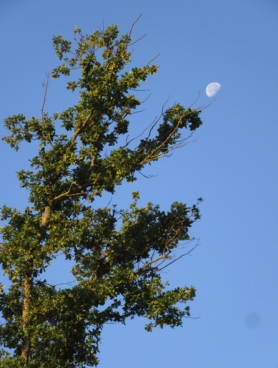
We learned that the plane trees along our mooring stretch had been cut down just a few moths ago, leaving a few misshapen oak trees to now spread and thrive.
 Whereas on the opposite side of the canal most plane trees are still in place, lighting up with a golden gleam in the evening sun.
Whereas on the opposite side of the canal most plane trees are still in place, lighting up with a golden gleam in the evening sun.
During our week’s sojourn here we noticed autumn creeping in. The days were much shorter and if we had got up on time it would almost have been in the dark! Leaves and acorns were falling, the latter with a clatter on the roof above our cabin.
And while on a nature theme I wasn’t to include this beautiful black cat with ’emerald blue’ eyes that lived nearby with at least half a dozen other cats of every hue.

We went out for a day to see our friend Chris at his farmstead near l’Abecede. It was a relaxing day for Captain Stu with no ropes or crew to concern him and he settled in to a day of wine and country talk of chickens, horses and vegetable growing.

On our way back to the boat we stopped at the l’Abecede lavoir ; I enclose a photo here just to illustrate how different the lavoirs on the Canal du Midi are to all others we have seen.

In our last days at Villesesquelande we had a couple of ‘moments’. The first was to suddenly, and against all the modern odds, to see a woman doing her laundry at the lavoir! She was beating her clothes with a big wooden paddle on the stones, just as in the past; fantastic.
 The second was a head to head between wine and grapes – or to be more precise between a tanker full of wine and two tractors hauling trailers full of grapes. Then tanker had tried to cross the narrow bridge, but been unable to turn the tight bend. This meant that it had a hundred yards of reversing along the canal bank, then backwards and down behind the bank, round a right angle bend back towards the village. This took some time. Whilst this was going on the two tractors appeared back from the vineyards, over the bridge, with their new loads. They simply had to wait, slowly moving along on the opposite Calliope, until the jam was untangled. The photo is of the blue lorry disappearing round the bend with the red and yellow tractors in close pursuit.
The second was a head to head between wine and grapes – or to be more precise between a tanker full of wine and two tractors hauling trailers full of grapes. Then tanker had tried to cross the narrow bridge, but been unable to turn the tight bend. This meant that it had a hundred yards of reversing along the canal bank, then backwards and down behind the bank, round a right angle bend back towards the village. This took some time. Whilst this was going on the two tractors appeared back from the vineyards, over the bridge, with their new loads. They simply had to wait, slowly moving along on the opposite Calliope, until the jam was untangled. The photo is of the blue lorry disappearing round the bend with the red and yellow tractors in close pursuit.
 After 11 glorious days with the view of the village, church tower, and old elm in our view through yellow dawns, golden blue days, and pink sunsets it was time to move to our winter resting place at Castelnaudary, a deliberately slow three day trip away.
After 11 glorious days with the view of the village, church tower, and old elm in our view through yellow dawns, golden blue days, and pink sunsets it was time to move to our winter resting place at Castelnaudary, a deliberately slow three day trip away.
We said good bye to our longest time in one mooring since April, with a last view through the bridge. Hopefully next Summer we will be back for a day or two.
Our next few days were to be of locks and lavoirs (Sorry!).

As we went under the next bridge at St-Eulalie Stewart spotted the smallest lavoir we have seen anywhere, although I am sure others exist that we have missed.
There was space for just three local washer women to be side by side chatting and scrubbing their way through the heaps of laundry.

We only travelled 6 kilometres that day, with one gentle lock to ascend. We passed over two aqueducts – l’Espitalet and Rebenty – both with beautiful old stonework dating back to the 17th century and still solidly in use.


By midday we were at Bram where we moored up for the rest of the day and night. It was a pleasant mooring in a small port.
By now it was Friday and our mooring place in Castel (as the locals call it) was not ready for us until midday on Saturday. We came on through gradually clearing skies to get within striking distance of Castel for next day.

Literally as we left Bram we came upon our first lavoir of the day. These on the Midi are a distinctly different style to those on the Borgogne.
After Bram écluse the next was Sauzens. The éclusier’s house was fairly typical of those on the Canal du Midi – much bigger than those on the canals in the North, and interesting because this was the first canal to be built. They obviously held their lock keepers in higher regard back then. I was amused by the iceberg of foam in the lock, and intrigued by yellow crocuses growing in September.

The next landmark was the lavoir at Villepinte. It is a good kilometre from the village – I would not have fancied carrying my load of sodden washing back home to dry!

We meandered on through the autumnal leaf dropping landscape looking for a place to moor up for lunch, and fund a set of sturdy mooring poles not much beyond Villepinte.
By the time we finished lunch the sun had arrived and shone hotly down for the rest of the day.

The next stretch starkly showed the problem with the plane tree disease, with those on our port side dead, and those on the starboard side seemingly healthy.
We altered our usual way of lock management at Tréboule to make it easier to get the ropes on bollards perched on quite a high lock wall. I was dropped off before the lock and walked ahead to catch ropes, meaning that I could also catch Calliope sliding under the bridge and into the typical Midi oval lock.
Tréboule offered more than a lock! There is also an aqueduct and a lavoir to absorb.
The countryside opened out with recently harvested yellow sloping hills on our right, villages visible in the distance, and more of the clinically blue skies we have almost come to take for granted.

The next lock goes by the wonderful name of Criminelle. I did ask the éclusier where the name originates form but she did not know.

I had one of my greatest wildlife surprises at Criminelle. Whilst waiting on the edge of the lock for Calliope to arrive I suddenly noticed a mink hurrying towards me carrying a fish!
I was caught so unawares that by the time I had the camera ready he was passing by my feet – inches away – and I had no time to properly focus.
Calliope made her stately way into the lock for what was quite a turbulent ascent. I enjoyed the spray from the water surge, cooling me down on a very warm day.
 Not far after Criminelle the map showed that there was an ‘Ancien lavoir’, just after the écluse at Guerre. This is one of the more picturesque lavoir locations; I think I would have enjoyed walking into the shade of this willow with my washing basket on a hot day, arms up to the elbows in the cool water and gossiping with my friends as I worked.
Not far after Criminelle the map showed that there was an ‘Ancien lavoir’, just after the écluse at Guerre. This is one of the more picturesque lavoir locations; I think I would have enjoyed walking into the shade of this willow with my washing basket on a hot day, arms up to the elbows in the cool water and gossiping with my friends as I worked.
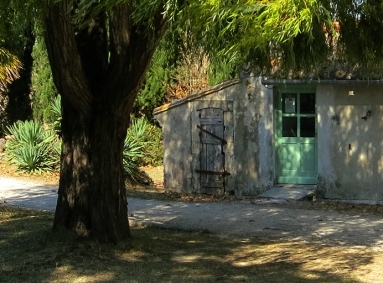
This was to be our last night this year on a ‘wild’ mooring – out in the country. As we approached St-Sernin lock Stewart suggested that I ask the éclusier if we could stay the night above the lock. The answer was ‘oui’ so we stopped.

The mooring was lovely………
 …….with a calm view back towards the lock.
…….with a calm view back towards the lock.

We made the most of this last rural night, sitting out on the back deck with wine, listening to the wind and the water.

Later we discovered we had been playing host to a beautiful moth, sleeping half way down the steps. By morning it had gone.
And so into the final days travelling this season – exactly 6 months after crossing the channel into St-Valery-sur-Somme we we would be ascending the final 10 locks into Castelnaudary port for the winter.

First lock of the day, Guillermine, was a single chamber, with an attractive ‘waterfall feature’ at the far end.

Although now close to Castelnaudary there was sill a rural feel to the area.
Then we came to the triple lock at Viziers, with an old mill to one side that is still in use.
The feeling was more industrial, with roads and buildings creeping in on all sides.
The double lock at Gay was quite easily ascended, so just the last set of four to go.

The St Roch staircase of four écluses is approached along a pretty tree lined length of canal, creating a sense of country within the town. The as Calliope turned the final been the full set appeared before us – along with a gathering audience of locals and tourists. As we ascended each lock the audience grew. Luckily all was going smoothly. All thrown ropes locked onto bollards; Stu controlled the boat against the weight of the water flow, and steered us from chamber to chamber without mishap.
The top lock was another matter! The placings of the bollards and the direction of the currents within the chamber made initial mooring more than a challenge, but we got there, and received a ‘Bravo’ from our fans.

We emerged into the Grand Bassin of Castelnaudary! Whoopee!
At the far end was the small bridge leading to the port and our haven. We had made it. We were there.
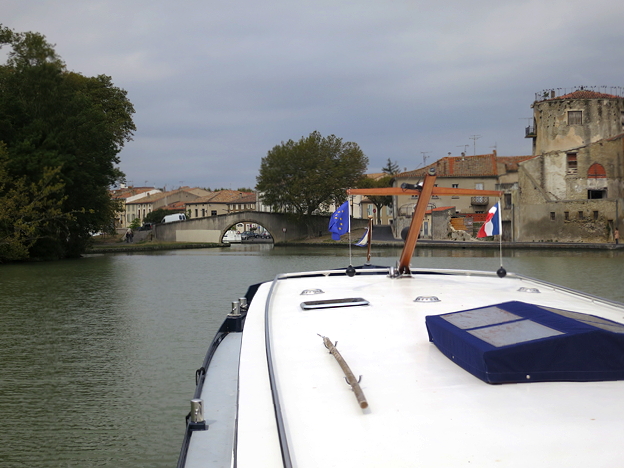
Our very old mate Chris has lived 10 minutes north of Castel for a long while, and four years ago we told him to put the kettle on because we were going to retire, buy a boat and come visit.
And here we, are moored up at our six month winter berth. Lovely. Really lovely. Relaxing.

What’s next? Well initially maintenance and the ‘winterising’ of the boat, then a flight home to see what its like being in a house again after a wonderful 18 months afloat. There’s decorating to do, grand children, family and friends to see, Christmas to plan.
And then there is deciding where we would like to go with Calliope next Spring. The adventure continues!









































































































































































